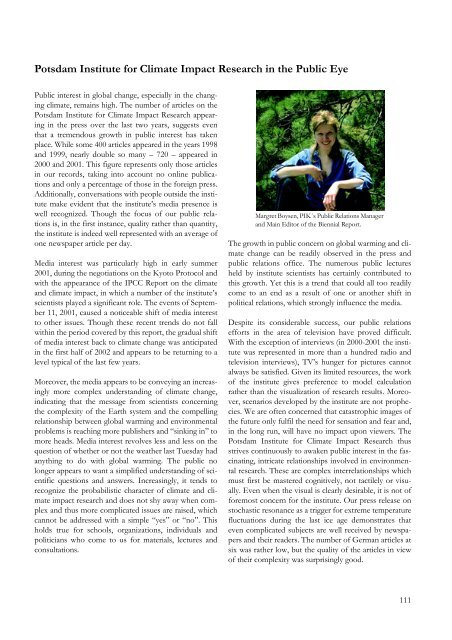PIK Biennial Report 2000-2001 - Potsdam Institute for Climate ...
PIK Biennial Report 2000-2001 - Potsdam Institute for Climate ...
PIK Biennial Report 2000-2001 - Potsdam Institute for Climate ...
Create successful ePaper yourself
Turn your PDF publications into a flip-book with our unique Google optimized e-Paper software.
<strong>Potsdam</strong> <strong>Institute</strong> <strong>for</strong> <strong>Climate</strong> Impact Research in the Public Eye<br />
Public interest in global change, especially in the changing<br />
climate, remains high. The number of articles on the<br />
<strong>Potsdam</strong> <strong>Institute</strong> <strong>for</strong> <strong>Climate</strong> Impact Research appearing<br />
in the press over the last two years, suggests even<br />
that a tremendous growth in public interest has taken<br />
place. While some 400 articles appeared in the years 1998<br />
and 1999, nearly double so many – 720 – appeared in<br />
<strong>2000</strong> and <strong>2001</strong>. This figure represents only those articles<br />
in our records, taking into account no online publications<br />
and only a percentage of those in the <strong>for</strong>eign press.<br />
Additionally, conversations with people outside the institute<br />
make evident that the institute’s media presence is<br />
well recognized. Though the focus of our public relations<br />
is, in the first instance, quality rather than quantity,<br />
the institute is indeed well represented with an average of<br />
one newspaper article per day.<br />
Media interest was particularly high in early summer<br />
<strong>2001</strong>, during the negotiations on the Kyoto Protocol and<br />
with the appearance of the IPCC <strong>Report</strong> on the climate<br />
and climate impact, in which a number of the institute’s<br />
scientists played a significant role. The events of September<br />
11, <strong>2001</strong>, caused a noticeable shift of media interest<br />
to other issues. Though these recent trends do not fall<br />
within the period covered by this report, the gradual shift<br />
of media interest back to climate change was anticipated<br />
in the first half of 2002 and appears to be returning to a<br />
level typical of the last few years.<br />
Moreover, the media appears to be conveying an increasingly<br />
more complex understanding of climate change,<br />
indicating that the message from scientists concerning<br />
the complexity of the Earth system and the compelling<br />
relationship between global warming and environmental<br />
problems is reaching more publishers and “sinking in” to<br />
more heads. Media interest revolves less and less on the<br />
question of whether or not the weather last Tuesday had<br />
anything to do with global warming. The public no<br />
longer appears to want a simplified understanding of scientific<br />
questions and answers. Increasingly, it tends to<br />
recognize the probabilistic character of climate and climate<br />
impact research and does not shy away when complex<br />
and thus more complicated issues are raised, which<br />
cannot be addressed with a simple “yes” or “no”. This<br />
holds true <strong>for</strong> schools, organizations, individuals and<br />
politicians who come to us <strong>for</strong> materials, lectures and<br />
consultations.<br />
Margret Boysen, <strong>PIK</strong>´s Public Relations Manager<br />
and Main Editor of the <strong>Biennial</strong> <strong>Report</strong>.<br />
The growth in public concern on global warming and climate<br />
change can be readily observed in the press and<br />
public relations office. The numerous public lectures<br />
held by institute scientists has certainly contributed to<br />
this growth. Yet this is a trend that could all too readily<br />
come to an end as a result of one or another shift in<br />
political relations, which strongly influence the media.<br />
Despite its considerable success, our public relations<br />
ef<strong>for</strong>ts in the area of television have proved difficult.<br />
With the exception of interviews (in <strong>2000</strong>-<strong>2001</strong> the institute<br />
was represented in more than a hundred radio and<br />
television interviews), TV’s hunger <strong>for</strong> pictures cannot<br />
always be satisfied. Given its limited resources, the work<br />
of the institute gives preference to model calculation<br />
rather than the visualization of research results. Moreover,<br />
scenarios developed by the institute are not prophecies.<br />
We are often concerned that catastrophic images of<br />
the future only fulfil the need <strong>for</strong> sensation and fear and,<br />
in the long run, will have no impact upon viewers. The<br />
<strong>Potsdam</strong> <strong>Institute</strong> <strong>for</strong> <strong>Climate</strong> Impact Research thus<br />
strives continuously to awaken public interest in the fascinating,<br />
intricate relationships involved in environmental<br />
research. These are complex interrelationships which<br />
must first be mastered cognitively, not tactilely or visually.<br />
Even when the visual is clearly desirable, it is not of<br />
<strong>for</strong>emost concern <strong>for</strong> the institute. Our press release on<br />
stochastic resonance as a trigger <strong>for</strong> extreme temperature<br />
fluctuations during the last ice age demonstrates that<br />
even complicated subjects are well received by newspapers<br />
and their readers. The number of German articles at<br />
six was rather low, but the quality of the articles in view<br />
of their complexity was surprisingly good.<br />
111

















